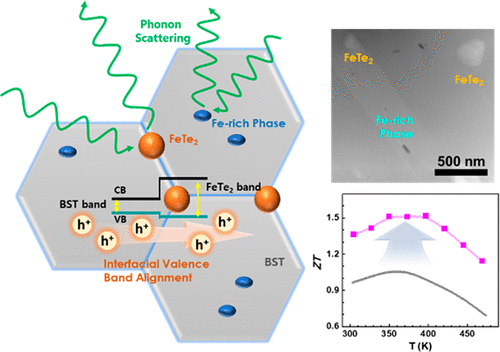当前位置:
X-MOL 学术
›
ACS Appl. Mater. Interfaces
›
论文详情
Our official English website, www.x-mol.net, welcomes your feedback! (Note: you will need to create a separate account there.)
Enhancing Thermoelectric Performances of Bismuth Antimony Telluride via Synergistic Combination of Multiscale Structuring and Band Alignment by FeTe2 Incorporation
ACS Applied Materials & Interfaces ( IF 9.5 ) Pub Date : 2018-01-19 00:00:00 , DOI: 10.1021/acsami.7b18451 Weon Ho Shin 1 , Jong Wook Roh 2 , Byungki Ryu 3 , Hye Jung Chang 4 , Hyun Sik Kim 2 , Soonil Lee 1 , Won Seon Seo 1 , Kyunghan Ahn 5
ACS Applied Materials & Interfaces ( IF 9.5 ) Pub Date : 2018-01-19 00:00:00 , DOI: 10.1021/acsami.7b18451 Weon Ho Shin 1 , Jong Wook Roh 2 , Byungki Ryu 3 , Hye Jung Chang 4 , Hyun Sik Kim 2 , Soonil Lee 1 , Won Seon Seo 1 , Kyunghan Ahn 5
Affiliation

|
It has been a difficulty to form well-distributed nano- and mesosized inclusions in a Bi2Te3-based matrix and thereby realizing no degradation of carrier mobility at interfaces between matrix and inclusions for high thermoelectric performances. Herein, we successfully synthesize multistructured thermoelectric Bi0.4Sb1.6Te3 materials with Fe-rich nanoprecipitates and sub-micron FeTe2 inclusions by a conventional solid-state reaction followed by melt-spinning and spark plasma sintering that could be a facile preparation method for scale-up production. This study presents a bismuth antimony telluride based thermoelectric material with a multiscale structure whose lattice thermal conductivity is drastically reduced with minimal degradation on its carrier mobility. This is possible because a carefully chosen FeTe2 incorporated in the matrix allows its interfacial valence band with the matrix to be aligned, leading to a significantly improved p-type thermoelectric power factor. Consequently, an impressively high thermoelectric figure of merit ZT of 1.52 is achieved at 396 K for p-type Bi0.4Sb1.6Te3–8 mol % FeTe2, which is a 43% enhancement in ZT compared to the pristine Bi0.4Sb1.6Te3. This work demonstrates not only the effectiveness of multiscale structuring for lowering lattice thermal conductivities, but also the importance of interfacial band alignment between matrix and inclusions for maintaining high carrier mobilities when designing high-performance thermoelectric materials.
中文翻译:

通过FeTe 2掺入多尺度结构和能带排列的协同结合提高碲化铋锑的热电性能
在基于Bi 2 Te 3的基质中形成分布均匀的纳米和中等尺寸的夹杂物,从而实现高热电性能的基质和夹杂物之间的界面处的载流子迁移率没有降低是困难的。在这里,我们成功地合成了具有富铁纳米沉淀和亚微米FeTe 2的多结构热电Bi 0.4 Sb 1.6 Te 3材料。常规固相反应,然后进行熔体纺丝和火花等离子烧结法制备夹杂物,这可能是大规模生产的便捷制备方法。这项研究提出了一种具有多尺度结构的碲化铋锑基热电材料,其晶格热导率大大降低,其载流子迁移率降到最低。这是可能的,因为在基质中精心选择的FeTe 2允许其界面价带与基质对齐,从而显着改善了p型热电功率因数。因此,对于p型Bi 0.4 Sb 1.6 Te 3 –8 mol%FeTe,在396 K时达到1.52的高热电品质因数ZT2,与原始Bi 0.4 Sb 1.6 Te 3相比,ZT增强了43%。这项工作不仅证明了多尺度结构化降低晶格热导率的有效性,而且还证明了在设计高性能热电材料时基质与内含物之间的界面能带对准对于保持高载流子迁移率的重要性。
更新日期:2018-01-19
中文翻译:

通过FeTe 2掺入多尺度结构和能带排列的协同结合提高碲化铋锑的热电性能
在基于Bi 2 Te 3的基质中形成分布均匀的纳米和中等尺寸的夹杂物,从而实现高热电性能的基质和夹杂物之间的界面处的载流子迁移率没有降低是困难的。在这里,我们成功地合成了具有富铁纳米沉淀和亚微米FeTe 2的多结构热电Bi 0.4 Sb 1.6 Te 3材料。常规固相反应,然后进行熔体纺丝和火花等离子烧结法制备夹杂物,这可能是大规模生产的便捷制备方法。这项研究提出了一种具有多尺度结构的碲化铋锑基热电材料,其晶格热导率大大降低,其载流子迁移率降到最低。这是可能的,因为在基质中精心选择的FeTe 2允许其界面价带与基质对齐,从而显着改善了p型热电功率因数。因此,对于p型Bi 0.4 Sb 1.6 Te 3 –8 mol%FeTe,在396 K时达到1.52的高热电品质因数ZT2,与原始Bi 0.4 Sb 1.6 Te 3相比,ZT增强了43%。这项工作不仅证明了多尺度结构化降低晶格热导率的有效性,而且还证明了在设计高性能热电材料时基质与内含物之间的界面能带对准对于保持高载流子迁移率的重要性。


























 京公网安备 11010802027423号
京公网安备 11010802027423号